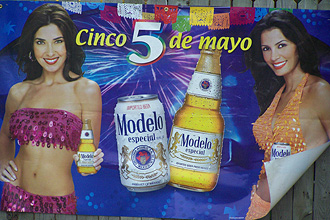
|
 |
 |
 Editorials | Issues | May 2008 Editorials | Issues | May 2008  
Cinco de Mayo Diluted by U.S. Liquor Industry
 Finding Dulcinea Finding Dulcinea
go to original


| | The cultural value of Cinco de Mayo has changed as the liquor industry cashes in on the holiday. | | |
The Cinco de Mayo holiday celebration marks Mexico’s victory over the French in the Battle of Puebla in 1862. Traditionally, only two Mexican cities celebrated the event — Puebla and Mexico City.

The Cinco de Mayo celebration caught on in the United States in the first half of the 20th century. “American-born youth of Mexican immigrant parents transformed Cinco de Mayo [into] a bicultural event that expressed their newfound Mexican-American identity,” according to a study on the Smithsonian Web site.

In the 1960s, the Chicano movement publicized the holiday as a means of expressing Hispanic-American pride and heritage. At that point, it began to attract the attention of the U.S. liquor industry, which adopted the holiday as a marketing tool.

Today, Cinco de Mayo is a widespread celebration, best known by many Americans for the spirits that define the day — Corona has even labeled itself “the original party beer of Cinco de Mayo.”

Over the past few years, some Mexican-Americans have denounced the commercialization and drinking traditions that have come to define “Drinko de Mayo”; meanwhile, others believe that the popularization of the Mexican tradition in America will encourage integration between the two cultures.

Headline Links: Is Cinco de Mayo too commercialized?

Some Mexican-Americans feel that Cinco de Mayo has been co-opted by alcohol companies and turned into “Drinko de Mayo.” According to a 2002 piece from the San Francisco Chronicle, an increasing number of Mexicans want to “take back” the holiday and restore the low-key traditions that were originally celebrated in Mexico.
Source: The San Francisco Chronicle

On May 1, 2008, Gustavo Arellano, columnist of the popular and provocative column “¡Ask a Mexican!” argued that celebrating cultural holidays helps immigrants become more accepted. As Americans increasingly participate in Cinco de Mayo festivities, they become “more and more comfortable with Mexicans being in this country and the idea of them ultimately being no different from other Americans.”
Source: Los Angeles Times

Reactions: Reclaiming Cinco de Mayo

The Cinco de Mayo con Orgullo Coalition was created in August of 2001 with the intention to “reclaim cultural celebrations—such as Cinco de Mayo—and cultural symbols from the alcohol industry,” according to the organization’s Web site. Each year the group organizes alcohol and tobacco-free celebrations.
Source: The Cinco de Mayo Con Orgullo Coalition (North City Prevention Coalition)

Historical Context: Cinco de Mayo in America
The Smithsonian Center for Latino Initiatives publishes a paper that explores the various ways in which the city of Corona, California, celebrated Cinco de Mayo from 1930–1950. While municipal authorities intended the holiday both to help integrate Mexican-Americans into the wider community and attract tourist dollars, Mexican-Americans used the occasion to reinforce cultural solidarity and political unity.
Source: Smithsonian Center for Latino Initiatives | 
 | |
 |



